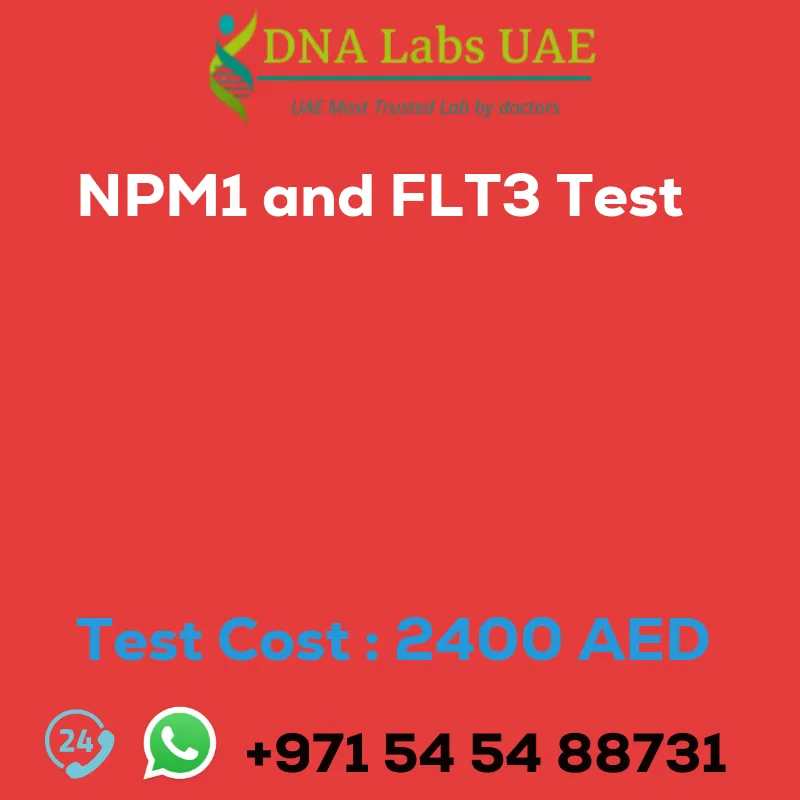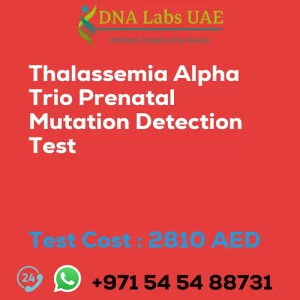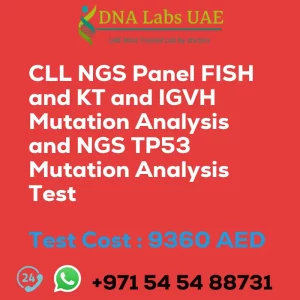NPM1 and FLT3 Test Cost AED: 2400.0 – Symptoms, Diagnosis, and Details
Test Name: NPM1 and FLT3 Test
Components: EDTA Vacutainer (2ml)
Price: 2400.0 AED
Sample Condition: Bone marrow / Peripheral blood (Transport immediately)
Report Delivery: 7-8 days
Method: Sanger Sequencing
Test Type: Genetics
Doctor: Gynecologist
Test Department: Pre Test Information
NPM1+FLT3 can be done with a doctor’s prescription. Prescription is not applicable for surgery and pregnancy cases or people planning to travel abroad.
Test Details
NPM1 and FLT3 are two genes that are often mutated in acute myeloid leukemia (AML). NPM1 (Nucleophosmin 1) is a gene that encodes for a protein involved in various cellular processes, including ribosome biogenesis and DNA repair. Mutations in the NPM1 gene are commonly found in AML and are associated with a favorable prognosis. These mutations result in the production of a mutant NPM1 protein that is localized in the cytoplasm instead of the nucleus. NPM1 mutations are often used as a diagnostic marker for AML.
FLT3 (FMS-like tyrosine kinase 3) is a gene that encodes for a receptor tyrosine kinase involved in cell growth and differentiation. Mutations in the FLT3 gene are also commonly found in AML and are associated with a poor prognosis. The most common FLT3 mutation is an internal tandem duplication (ITD) in the juxtamembrane domain, which leads to constitutive activation of the FLT3 receptor. Other FLT3 mutations, such as point mutations in the tyrosine kinase domain, can also occur.
NPM1 and FLT3 mutations are often mutually exclusive in AML, meaning that patients with one mutation are unlikely to have the other. However, in some cases, patients can have both mutations, which may have implications for prognosis and treatment response. The presence of an NPM1 mutation without a FLT3 mutation is associated with a favorable prognosis, while the presence of a FLT3 mutation, especially with an ITD, is associated with a poor prognosis.
Targeted therapies have been developed to specifically inhibit the FLT3 receptor in AML patients with FLT3 mutations. These drugs, such as FLT3 inhibitors, have shown promising results in clinical trials and are being used in the treatment of AML patients with FLT3 mutations. However, there are currently no targeted therapies specifically approved for the treatment of AML patients with NPM1 mutations.
| Test Name | NPM1andFLT3 Test |
|---|---|
| Components | EDTA Vacutainer (2ml) |
| Price | 2400.0 AED |
| Sample Condition | Bone marrow \/ Peripheral blood (Transport immediately) |
| Report Delivery | 7-8 days |
| Method | Sanger Sequencing |
| Test type | Genetics |
| Doctor | Gynecologist |
| Test Department: | |
| Pre Test Information | NPM1+FLT3 can be done with a Doctors prescription. Prescription is not applicable for surgery and pregnancy cases or people planing to travel abroad. |
| Test Details |
NPM1 and FLT3 are two genes that are often mutated in acute myeloid leukemia (AML). NPM1 (Nucleophosmin 1) is a gene that encodes for a protein involved in various cellular processes, including ribosome biogenesis and DNA repair. Mutations in the NPM1 gene are commonly found in AML and are associated with a favorable prognosis. These mutations result in the production of a mutant NPM1 protein that is localized in the cytoplasm instead of the nucleus. NPM1 mutations are often used as a diagnostic marker for AML. FLT3 (FMS-like tyrosine kinase 3) is a gene that encodes for a receptor tyrosine kinase involved in cell growth and differentiation. Mutations in the FLT3 gene are also commonly found in AML and are associated with a poor prognosis. The most common FLT3 mutation is an internal tandem duplication (ITD) in the juxtamembrane domain, which leads to constitutive activation of the FLT3 receptor. Other FLT3 mutations, such as point mutations in the tyrosine kinase domain, can also occur. NPM1 and FLT3 mutations are often mutually exclusive in AML, meaning that patients with one mutation are unlikely to have the other. However, in some cases, patients can have both mutations, which may have implications for prognosis and treatment response. The presence of an NPM1 mutation without a FLT3 mutation is associated with a favorable prognosis, while the presence of a FLT3 mutation, especially with an ITD, is associated with a poor prognosis. Targeted therapies have been developed to specifically inhibit the FLT3 receptor in AML patients with FLT3 mutations. These drugs, such as FLT3 inhibitors, have shown promising results in clinical trials and are being used in the treatment of AML patients with FLT3 mutations. However, there are currently no targeted therapies specifically approved for the treatment of AML patients with NPM1 mutations. |








